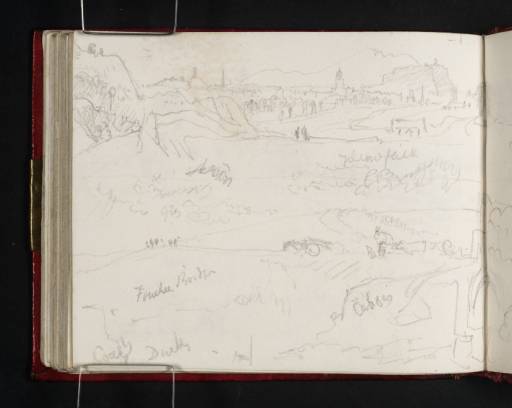Joseph Mallord William Turner Edinburgh, from Braid Hill; a Pastoral Landscape 1818
Image 1 of 2
Joseph Mallord William Turner,
Edinburgh, from Braid Hill; a Pastoral Landscape
1818
Joseph Mallord William Turner 1775–1851
Folio 62 Verso:
Edinburgh, from Braid Hill; a Pastoral Landscape 1818
D13570
Turner Bequest CLXVI 62a
Turner Bequest CLXVI 62a
Pencil on white wove paper, 90 x 112 mm
Inscribed in pencil by Turner across the page
Inscribed in pencil by Turner across the page
Accepted by the nation as part of the Turner Bequest 1856
References
1909
A.J. Finberg, A Complete Inventory of the Drawings of the Turner Bequest, London 1909, vol.I, p.483, CLXVI 62a, as ‘Edinburgh, from Braid Hill, &c.’.
Turner’s notes across this page are: ‘yellow flack’ upper-centre right, ‘grey’ left centre, ?‘F[...] Bridge’ lower centre left, ‘C[...]’ bottom right, ?‘Coaly Ducks’ bottom left.
This sketch of Edinburgh from Braid Hill is one of numerous views that Turner made of the city from the southern outskirts (see Bass Rock and Edinburgh Tate D13399; Turner Bequest CLXV 44). Taken from the foot of the hill, just over two miles to the south of the city, we look towards Edinburgh Castle which is silhouetted against the distant hills, with the spires of the city’s many churches. Ahead of the point where Turner stands, two dark figures also stand to enjoy the view. This motif is one that Turner takes up in other sketches from this tour, such as one in the Scotch Antiquities sketchbook of figures on Calton Hill (D13653), and in various paintings with Scottish subjects, e.g., Edinburgh from Calton Hill, circa 1819 (watercolour, National Gallery of Scotland),1 and Melrose, 1831 (National Gallery of Scotland).2 A double-page sketch in the Abbotsford sketchbook of 1831 (Tate D25939–D25940; Turner Bequest CCLXVII 7a–8) shows a similar view of Edinburgh from Braid Hill, although taken from higher up the hill and therefore with a more panoramic vista.
The bottom two-thirds of the page are taken up with a view towards a hill with a track running alongside it. A small procession moves along the track towards the left of the picture with a group of figures at the head, followed by a horse-drawn cart, and a herdsman leading cattle. Even in this rapid sketch and with tiny figures there is a sense of the group’s hard progress. The horse’s head is strained forward under the weight of his load and the herdsman lags behind he rest of the group as he tries to drive his animals forward. These incidents of pastoral life are rare in the 1818 Scottish sketches, with just a few further examples in the Scotch Antiquities sketchbook (Tate D13706 and D13712; Turner Bequest CLXVII 67, 70). However the pastoral nature of the landscape is taken up in three Provincial Antiquities works: Crichton Castle, circa 1818 (The Morgan Library and Museum, New York),3 and Linlithgow Palace, 1821 (Manchester City Galleries),4 which both feature herdsmen and cattle in the foreground, and Borthwick Castle, 1818 (watercolour, Indianapolis Museum of Art),5 with men leading horses.
In addition to these incidents Turner has included patchy clouds in the sky along with colour notes (‘grey’ and ‘yellow fleck’), and further notes on the landscape. The scene is likely to show a landscape within ten miles of the south of Edinburgh.
Thomas Ardill
February 2008
How to cite
Thomas Ardill, ‘Edinburgh, from Braid Hill; a Pastoral Landscape 1818 by Joseph Mallord William Turner’, catalogue entry, February 2008, in David Blayney Brown (ed.), J.M.W. Turner: Sketchbooks, Drawings and Watercolours, Tate Research Publication, December 2012, https://www


